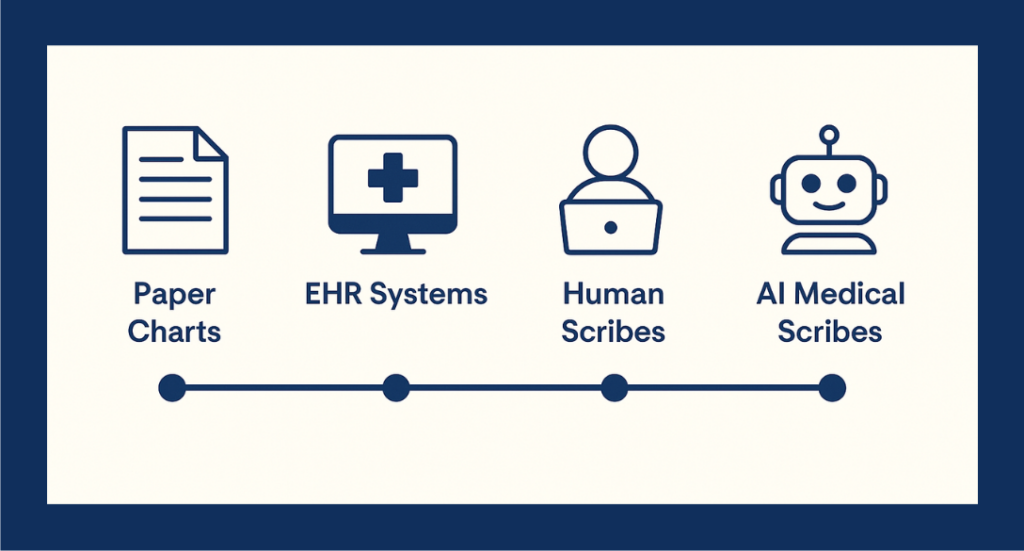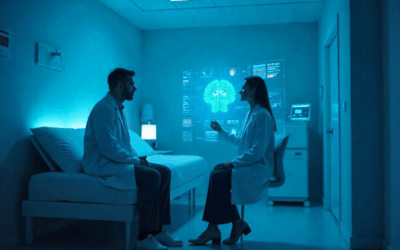Quick Summary
- Historical origins: Paper charts and handwritten notes
- EHR adoption: Transforming workflows but adding documentation burden
- Human scribes: Helping but costly and error-prone
- AI-powered medical scribes: Automating documentation with ambient clinical technology
- Benefits: Saves time, reduces burnout, improves accuracy
- Future: Predictive documentation, deeper EHR integration, better patient care
✅ Learn more about Dorascribe’s AI Medical Scribe solutions
From Paper Charts to Digital Documentation
Healthcare documentation made a huge leap when scribing evolved from manual to computerized systems. Doctors used to handwrite notes in physical charts, which was pretty straightforward but led to lost records and illegible handwriting.

Electronic health record systems shook things up. EHRs let clinics store information in an organized way, making it way easier to share between providers and ditch the old filing cabinets.
But digital systems brought their own set of problems. Many doctors found themselves typing more and talking less during visits, and the complicated software often made appointments feel less personal.
The Emergence of Electronic Health Records (EHRs)
The widespread adoption of EHRs in the 2000s and 2010s aimed to solve the paper problem, but many clinicians found themselves overwhelmed by the demands of digital documentation.
Studies show that clinicians can spend up to half their day on EHR tasks, contributing to administrative burden and burnout. Physicians often faced complex interfaces, repetitive data entry, and the challenge of maintaining patient engagement while typing notes.
Related: How Dorascribe Enhances Efficiency and Patient Care
The Role of Human Medical Scribes
To address these issues, many practices turned to human medical scribes. These professionals accompany physicians during patient visits, capturing notes in real-time.
Advantages:
- Allows physicians to focus on patient interaction
- Reduces EHR time for doctors
Drawbacks:
- Costly to hire and train
- Potential for human error
- Privacy and compliance considerations
Medical scribes face challenges like cost and training needs. They lighten the load, but don’t solve every documentation problem.
The Shift to AI-Powered Medical Scribing
Now, more providers are turning to AI-powered medical scribing systems. These tools use speech recognition and natural language processing to capture doctor-patient conversations as they happen.
Key AI Technologies:
- Speech recognition turns spoken words into text
- Natural language processing figures out what’s important
- Machine learning gets smarter with more use
- Artificial intelligence organizes tricky medical terminology
Benefits:
- Saves clinicians hours each week
- Reduces documentation errors
- Enhances patient engagement by removing screens from the encounter
- Lowers costs compared to human scribes
Dorascribe’s AI-powered scribe listens, transcribes, and organizes SOAP notes automatically, supporting specialties from emergency medicine to primary care.
Comparing Traditional vs. AI Medical Scribes
| Feature | Human Medical Scribe | AI Medical Scribe |
| Cost | High (salary/contract) | Lower (subscription-based) |
| Accuracy | Human error potential | Consistent, improves with training |
| Availability | Limited (scheduling, turnover) | 24/7, on-demand |
| Integration | Manual EHR input | Seamless EHR integration |
| Burnout Reduction | Moderate relief | Significant relief |
AI scribes skip the headaches of scheduling and turnover. They offer easy EHR integration and don’t need anyone to retype notes.
The Future of Medical Scribing and Clinical Documentation
The future of medical scribing is AI-first:
- Ambient listening for hands-free notes
- Smart EHR connections that cut down on clicks
- Predictive text for faster notes
- Workflows tailored to different specialties
As AI continues to evolve, medical scribes will move beyond simply recording notes to improving care quality itself.
This shift helps tackle physician burnout by giving time back to patient care. Consistent, thorough records make things safer for patients and smoother for care teams.
For example, Dorascribe is focused on developing tools that learn from clinicians, adapt to specialty workflows, and ensure security and compliance with healthcare standards.
FAQ About AI Medical Scribing
What does an AI medical scribe do?
An AI medical scribe uses advanced speech recognition and natural language processing to listen to clinician-patient conversations and automatically generate structured clinical notes for the EHR.
How does passive clinical documentation function?
Ambient clinical documentation captures conversations during visits unobtrusively, generating complete, structured notes without requiring the clinician to type or dictate manually.
How does AI medical scribing reduce physician burnout?
By automating documentation tasks, AI scribes free clinicians to spend more time with patients and less time on administrative work, significantly reducing stress and burnout.
Is AI medical scribing secure and HIPAA compliant?
Yes. Leading AI scribe solutions prioritize data privacy and security, with robust encryption and compliance with HIPAA and other healthcare regulations.
How can I get started with an AI medical scribe?
Learn more about Dorascribe’s AI Medical Scribe solutions and book a demo here.
Conclusion: Embracing AI for Better Care
The journey from paper charts to AI-powered medical scribes reflects healthcare’s broader shift toward smarter, more efficient, and patient-centered care.
AI medical scribes like Dorascribe are transforming documentation from a burden into a seamless, invisible process—empowering clinicians to focus on what matters most: delivering exceptional patient care.
👉 Ready to reduce your documentation burden?
Discover Dorascribe’s AI Medical Scribe today.




